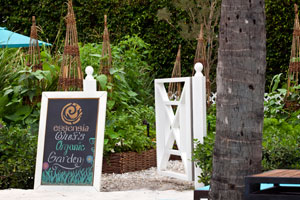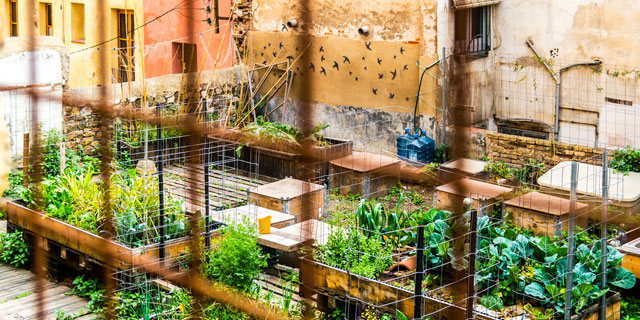For most folks in the restaurant and bar business, the urban garden – a patch of produce tended in the middle of a metropolis – was born out of necessity. This meant that for whatever reason, the chef or mixologist in question couldn’t find a particular type of rare herb, or have enough of carved radish garnish at the ready, or keep a particular berry fresh and vital for when it was required for that special drink or dish. So they scratched out a seasonal garden from what used to be a pathway, or carved one into a climbing wall like ivy, or raised one on a rooftop.
These days, such gardens are hardly new. In fact, in recent years, they’ve pretty much gone out of fashion. As farm-to-fork produce became more available nationally in the past decade, and foragers began to appear more readily at the kitchen back doors, many American chefs and bar managers actually let go of their little pieces of earth and sky. It was easier to buy than grow it themselves, frankly, and in busy cities like New York, Chicago, and Los Angeles, it’s hard not to be able to find whatever it is your dish requires – even if it’s not in season or local to the region.
But the past year or so has seen a resurgence in the urban garden, and it’s largely thanks to Latin, Caribbean, or rural chefs and mixologists who have launched their own venues. Many grew up in much poorer countries, raising chickens, pigs, and vegetables for their families’ main sustenance, or in places where land or water is at a premium. Thus they have a different outlook on this business of farming, foraging, cooking, and serving.
For one thing, they’ve learned to count on no one but themselves. There’s a do-it-yourself quality to the urban kitchen that provides a quiet satisfaction for the grower that translates to the customer.
For instance, Rick Bayless, pioneer of the urban garden in Chicago, and his garden manager Bill Shores were so successful at transforming three Bucktown lots that they’re now considered, notes the website, a “a model for urban food production and demonstrate[s] that gardens can be simultaneously functional and beautiful. With a mix of traditional beds, raised beds, containers, vertical and indoor garden spaces, the visitor will be inspired and come away with a multitude of ideas and techniques to incorporate into their own garden spaces.”
Any chef or mixologist desiring to start his or her own urban garden is well advised to visit and glean information about the incredible use of space that Rick and Deanna Bayless and Shores have managed for their restaurants. These include the ultra-popular Frontera Grill, Topolobampo, and Xoco, all of which feature Midwestern produce picked at the height of the season.
Gabriel Orta, owner of the Broken Shaker in Miami Beach, which is coming soon to Chicago, has taken at least the first page from the Bayless book. He recently built and planted raised beds by the back courtyard in his and partner Elad Zvi’s host venue, the Freehand Miami hostel. Known for his innovative, award-winning cocktails comprising herbs, fruits and vegetables, Orta says, “We always want to give our customers the freshest of produce we can source.”
[pagebreak]In New York, Iroquois Hotel executive chef Florian Wehrli of Triomphe restaurant has been personally designing the rooftop space of the boutique hotel to fit his gardening needs. He's really crafting it, too – hand-building boxes and planters in his home in western New Jersey farmland home, then bringing them into the city. “I get some strange looks at 4:30 a.m. on the bus into the city,” he laughs about carrying in planks for raised beds and tomato towers. “But it’s worth it to be able to take advantage of the full sun I get up here. And the customers appreciate the freshness of everything, from the nasturtiums to the fennel. I’ve even built a potato bed, for Kennebecs and [Peruvian] blues.”
Indeed, it’s always all about the customer. A couple of miles south of Broken Shaker, Signature Chef Julie Frans of Essensia at The Palms Hotel & Spa says about her garden, “We have some regulars who like to come and pick their own kale or herbs for their dinner. Other guests have requested a custom dinner made from garden-picked ingredients. On a more regular basis, it gives me a chance to connect our guests with the process, and talk about seasons, growing, and why it's critical to know where our food comes from. I like to offer a lot of specialty ingredients that people wouldn't find in a grocery store, introducing new sights and smells to excite them. It's exciting to discover new foods with people, and get them involved in the process.”
But Frans, Wehrli, and Bayless see an even greater future for the customer. The clients of Bayless already demand tours of his three-lot garden – so many that there’s a waiting list on the Wednesday evening slots. Frans holds yoga classes in the garden and pairs them with prix fixe dinner specials. Wehrli envisions tables – not this season but next – placed next to the vintage water tower in the midst of flourishing vegetables, and holding special events there for businesses or personal reasons like engagement parties.
Of course, these chefs could simply buy their produce, and they do to supplement what they grow. In New York, Eagle Street Farms grows more than 160 varieties of peppers – enough to keep any Hispanic chef in paroxysms of delight. In South Florida, 10 miles to the south of Miami, Homestead is known as the "breadbasket of the South,” and it rivals New Jersey for production of heirloom tomatoes. And in New Jersey, where Wehrli lives, he counts the owner of Verona Farms as one of his closest friends, and harvests the pheasant he puts on his menu at another farm a couple of miles down the road.
But their mission is also more self-reflective than that. As Wehrli says, “You can find anything in New York City, but you can’t necessarily control it.” This is why he grows cape gooseberries on his roof, and picks them for his dishes when they’re small. “I like to keep them pea size,” he says.
Others, such as Thiago and Felipe Castanho of Remanso do Bosque in the Brazilian Amazon near Belém, want to simply snip and pluck their ingredients from the immediate surroundings. The Castanho brothers, whose restaurant name translates to “a quiet place in the woods,” are known not only for maintaining a kitchen garden, but for foraging directly from the jungle, where items such as lemon grass grow freely.
[pagebreak]This is a connection with the food that translates directly to the plate, and therefore to the patron. San Diego native Frans, who as a Californian has grown up hyper conscious of her carbon footprint, agrees: “By having our own garden, I am connected to the soil and the seasons, and can always offer something fresh and homegrown to our guests.”
Likewise, Orta notes, “We grow ingredients we love to use like starfruit, lemongrass, hibiscus and herbs for cocktails of all kinds and Chinese spinach, white eggplants, herbs, hot peppers and arugula for the food.” In addition, there’s very little waste, and what there is can be used for composting. “Our menu changes every ten days, so that way we can incorporate everything we are harvesting,” Orta continues.
Then there’s those chefs who are not only used to making do with reaping much out of little, they tend to view the world with a give-and-get-back mentality. Just because you’re buying locally and seasonally, that may not mean you’re buying responsibly. “We are trying to be as sustainable as possible,” Orta says. “When it comes down to growing, we keep it simple and old school: organic soil and food plant and plenty of water.”
Frans and The Palms Hotel & Spa also garden organically; so does the RebelEarth Urban farm, which is actually LEED certified. Located in Escazu, Costa Rica, at the Sheraton San Jose, the farm grows for the two on-site restaurants: Kitchen by Rausch, the fine-dining spot, and the more casual Grand Casino Restaurant. But because space is limited, the farm uses the Future Growing Tower Garden concept, a trademarked, vertical aeroponic technology that requires 90 percent less land and 95 percent less water than conventional organic farming.
In Southern California, where water is always an enormous issue, Santa Fe-born chef John Rivera Sedlar is familiar with conservation issues. He also employs the Tower Garden system on the rooftop of his neo-Latin, Los Angeles-based restaurant Rivera. On the Future Growing website, he gives one very succinct reason for his choice back in 2012, when he opened the establishment: “I couldn’t find what I needed from the farmers—or from the markets—for our urban Latin kitchen downstairs.”
One of his partners, Bill Chait, follows up with some additional praise for the system, including the fact that because the water used is pure, the food grown is free of diseases and chemicals. Plus, he notes, “Here, we’re utilizing space that would otherwise be ‘fallow land’, as it were. And in terms of cost, the towers are much more efficient at producing crops per square inch than any other system, because we are growing up instead of out.”
Owned by Tim Blank, Future Growing’s technology and the Tower Garden products seem revolutionary. But in reality, they allow just about anyone with a modicum of space – rooftop or otherwise – to grow just about anything. Today, he has about 100 clients internationally. But it’s only a matter of time before chefs and mixologists with homespun mentality make vertical gardens as normcore as they did farm to fork.


![Making Mealtime Matter with La Familia: Easy Sofrito [Video]](https://thelatinkitchen.com/wp-content/uploads/2015/10/sofrito-shutterstock__0-500x383.jpg)
![Easy Latin Smoothies: Goji Berry Smoothie [Video]](https://thelatinkitchen.com/wp-content/uploads/2015/12/goji_berry-shutterstock_-500x383.jpg)
















![Fun and Fast Recipes: Fiesta Cabbage Salad [Video]](https://thelatinkitchen.com/wp-content/uploads/2015/11/fiesta_cabbage_slaw-shutterstock_-500x383.jpg)









